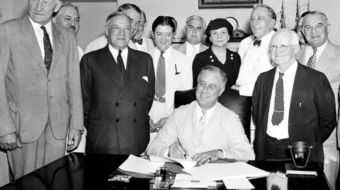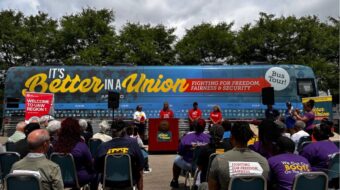Opinion
One of the proudest achievements of the U.S. labor movement, the retired worker’s monthly pension check, is in deepening trouble.
Union-negotiated defined-benefit plans supposedly provide a monthly pension check for life, insured by a federal agency, the Pension Benefit Guarantee Corporation (PBGC). But with the recent rash of corporate bankruptcies, the PBGC is running short of reserves to bail out failing plans. When it does implement a bailout, it funds the workers’ pensions at a reduced level.
Since 1985, nearly 115,000 defined-benefit plans, covering 7 million workers, have been terminated. Only 32,231 mostly larger plans remain in effect. Because many are provided by major employers, these plans cover 44 million workers.
Defined-benefit plans are increasingly being replaced by defined-contribution plans, such as 401(k)s. Corporations love these plans. They shift the cost and the risk from the employer to the worker.
During the 1990s stock boom, 401(k)s were touted as the road to riches. But the stock market has lost about $4.7 trillion in shareholder value since the market peak in March of 2000. Combined with falling interest rates, this market plunge cut deeply into the assets of the 401(k) plans. Enron and WorldCom workers, for example, collectively lost more than $2 billion in 401(k) savings when their stock went in the tank.
Older companies in industries like steel and auto face the “legacy costs” of thousands of retirees with defined-benefit plans. General Motors, for example, recently ponied up $13.5 billion for its pension funds. Employers are fighting to scale back the amount they are required by law to contribute to their defined-benefit plans. But many of these plans are already under-funded. If they were to be terminated their assets would not be sufficient to pay promised benefits.
“As baby boomers near retirement, the pension system is wobbling,” warms Peter R. Orszag of the Brookings Institution. Bills now in Congress would at best patch up the existing system.
There’s still another problem. Most pensions don’t have cost-of-living adjustments. The security provided to private-sector retirees is largely illusory owing to the steady erosion of the buying power of an unchanging monthly pension check.
Thus, millions of workers live on incomes that shrivel, year by year, writes syndicated columnist Scott Burns.
“A person who retired 25 years ago with a pension of $10,000 a year would have lived through a compound annual inflation rate of 4.4 percent a year,” says Burns. “That would have reduced the original purchasing power to only $3,408.”
Labor is fighting a bruising rear-guard battle to protect and where possible to expand its defined-benefit plans.
“We have to draw a line in the sand to protect these plans’ integrity so they don’t disappear into the night,” says David Blitzstein, director of negotiated benefits for the United Food and Commercial Workers.
Unions are fully justified in defending their hard-won pension gains, which were largely bargained in trade-offs with reduced take-home pay, and upon which millions of their members depend. But in the final analysis, employer-based pensions are dependent on the uncertain economic health of the employer, which in turn is usually dependent on the health of the economy.
Even as labor defends these precious retirement benefits, how about launching a campaign to at least double the Social Security entitlement?
That would bring the “other half” of the working class – those with no pensions of any kind and with the greatest need – into the system. And it would provide an assurance of retirement income security no patchwork of employer-based plans could match.
It would also bring U.S. workers into line with their brothers and sisters in many industrial nations, where every worker is part of a national pension fund – and where the entire class benefits.
Will Parry is a retired trade unionist in Washington state. He can be reached at pscsc@qwest.net.









